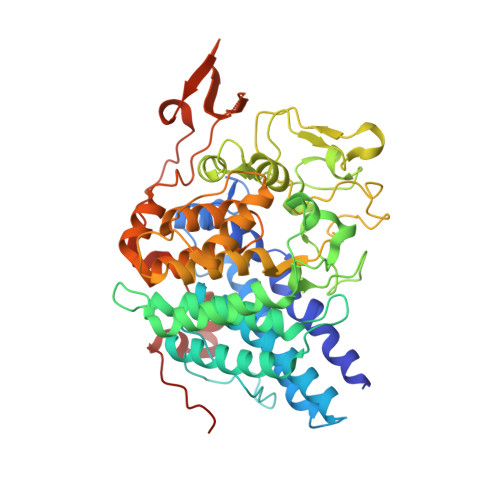Molecular Dissection of Xyloglucan Recognition in a Prominent Human Gut Symbiont.
Tauzin, A.S., Kwiatkowski, K.J., Orlovsky, N.I., Smith, C.J., Creagh, A.L., Haynes, C.A., Wawrzak, Z., Brumer, H., Koropatkin, N.M.(2016) mBio 7: e02134-e02115
- PubMed: 27118585
- DOI: https://doi.org/10.1128/mBio.02134-15
- Primary Citation of Related Structures:
5E75, 5E76, 5E7G, 5E7H - PubMed Abstract:
Polysaccharide utilization loci (PUL) within the genomes of resident human gut Bacteroidetes are central to the metabolism of the otherwise indigestible complex carbohydrates known as "dietary fiber." However, functional characterization of PUL lags significantly behind sequencing efforts, which limits physiological understanding of the human-bacterial symbiosis. In particular, the molecular basis of complex polysaccharide recognition, an essential prerequisite to hydrolysis by cell surface glycosidases and subsequent metabolism, is generally poorly understood. Here, we present the biochemical, structural, and reverse genetic characterization of two unique cell surface glycan-binding proteins (SGBPs) encoded by a xyloglucan utilization locus (XyGUL) from Bacteroides ovatus, which are integral to growth on this key dietary vegetable polysaccharide. Biochemical analysis reveals that these outer membrane-anchored proteins are in fact exquisitely specific for the highly branched xyloglucan (XyG) polysaccharide. The crystal structure of SGBP-A, a SusD homolog, with a bound XyG tetradecasaccharide reveals an extended carbohydrate-binding platform that primarily relies on recognition of the β-glucan backbone. The unique, tetra-modular structure of SGBP-B is comprised of tandem Ig-like folds, with XyG binding mediated at the distal C-terminal domain. Despite displaying similar affinities for XyG, reverse-genetic analysis reveals that SGBP-B is only required for the efficient capture of smaller oligosaccharides, whereas the presence of SGBP-A is more critical than its carbohydrate-binding ability for growth on XyG. Together, these data demonstrate that SGBP-A and SGBP-B play complementary, specialized roles in carbohydrate capture by B. ovatus and elaborate a model of how vegetable xyloglucans are accessed by the Bacteroidetes The Bacteroidetes are dominant bacteria in the human gut that are responsible for the digestion of the complex polysaccharides that constitute "dietary fiber." Although this symbiotic relationship has been appreciated for decades, little is currently known about how Bacteroidetes seek out and bind plant cell wall polysaccharides as a necessary first step in their metabolism. Here, we provide the first biochemical, crystallographic, and genetic insight into how two surface glycan-binding proteins from the complex Bacteroides ovatus xyloglucan utilization locus (XyGUL) enable recognition and uptake of this ubiquitous vegetable polysaccharide. Our combined analysis illuminates new fundamental aspects of complex polysaccharide recognition, cleavage, and import at the Bacteroidetes cell surface that may facilitate the development of prebiotics to target this phylum of gut bacteria.
Organizational Affiliation:
Michael Smith Laboratories and Department of Chemistry, University of British Columbia, Vancouver, British Columbia, Canada.


















